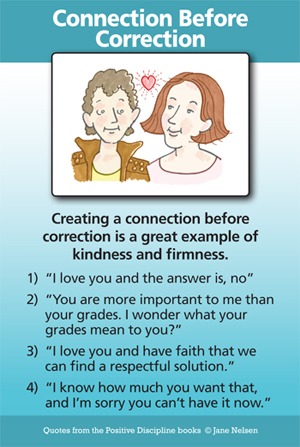
The one Positive Discipline Tool I wish I had used more consistently is this: Connection before Correction. Of course, I didn't know what this meant as a young mother, and didn't create it as a Positive Discipline tool until about five years ago. Now we know it is just brain science: children learn (grow, feel safe, thrive) best when they feel connection—or as Alfred Adler and Rudolf Dreikurs taught us, "a sense of belonging and significance".
Extensive research shows that we cannot influence children in a positive way until we create a connection with them. It is a brain (and heart) thing. Sometimes we have to stop dealing with the misbehavior and first heal the relationship.
Connection creates a sense of safety and openness. Punishment, lecturing, nagging, scolding, blaming or shaming create fight, flight, or freeze.
One of my favorite examples of “connection before correction” is, “I love you; and the answer is no.” This example also illustrates the Positive Discipline concept of Kind and Firm at the same time.
Before sharing more ways to create a connection with children, I want to point out that it is a mistake to think that giving children whatever they want is effective. Rescuing, fixing, and over-protecting are not good ways to create a connection. Effective connections are made when both child and adult feel belonging and significance. Most of the Positive Discipline parenting tools provide skills for creating a connection.
They will all be discussed in more detail as we choose a card each week. Following is a preview:
- Spend special time with children. What could create a greater connection for your child than to know you enjoy spending time with him or her.
- Listen. Really listen. Stop doing whatever you are doing and give your child your full attention
- Validate your child’s feelings. Don’t we all feel connected when we feel understood?
- Share your feelings and thoughts when appropriate. Remember that children will listen to you AFTER they feel listened to. Children feel a connection when you respectfully share something about yourself. Respectfully, means no stories about walking miles in the snow.
- Focus on solutions WITH children after a cooling off period. There is that word "with" again–because it is a golden bridge to connection.
- Ask curiosity questions to help children explore the consequences of their choices instead of imposing consequences on them. Sincere questions open the heart and the rational brain—equaling connection.
- Hugs. There are times when all of us need nothing more than a hug.
Once the connection is made, children are then open to respectful correction.
It is important to understand that "Correction" in the Positive Discipline way is very different from conventional correction. The biggest difference is that conventional correction usually involves punishment (punitive time-out, grounding, and taking away privileges being the most common). In other words, conventional correction consists of adults doing something TO children. Positive Discipline correction respectfully involves children whenever possible, finding solutions WITH them.
Two great methods for finding solutions are family meetings or class meetings and joint problem solving. These are powerful tools that respectfully involve children to learn and use their personal power in contributing ways. Connection is created as part of the process.
When children feel a connection, they feel belonging and significance. Often that is enough for misbehavior to stop. As you learn about the many Positive Discipline tools, notice that they are all designed to create a connection before respectful correction.


